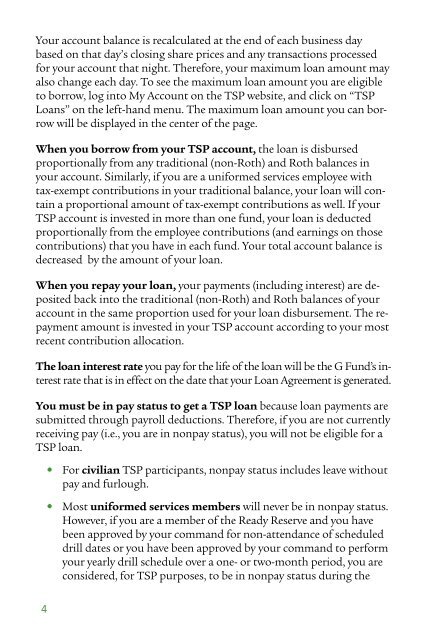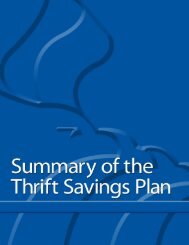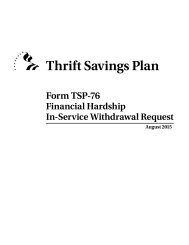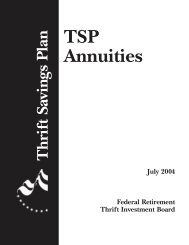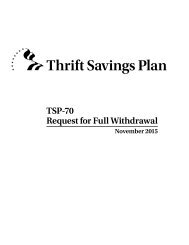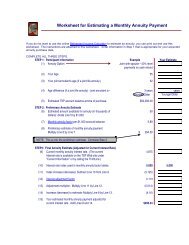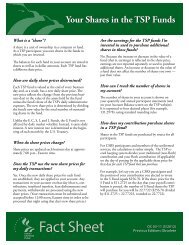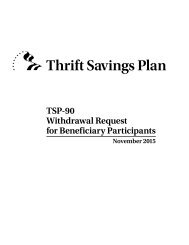TSP Loans
You also want an ePaper? Increase the reach of your titles
YUMPU automatically turns print PDFs into web optimized ePapers that Google loves.
Your account balance is recalculated at the end of each business day<br />
based on that day’s closing share prices and any transactions processed<br />
for your account that night. Therefore, your maximum loan amount may<br />
also change each day. To see the maximum loan amount you are eligible<br />
to borrow, log into My Account on the <strong>TSP</strong> website, and click on “<strong>TSP</strong><br />
<strong>Loans</strong>” on the left-hand menu. The maximum loan amount you can borrow<br />
will be displayed in the center of the page.<br />
When you borrow from your <strong>TSP</strong> account, the loan is disbursed<br />
proportionally from any traditional (non-Roth) and Roth balances in<br />
your account. Similarly, if you are a uniformed services employee with<br />
tax-exempt contributions in your traditional balance, your loan will contain<br />
a proportional amount of tax-exempt contributions as well. If your<br />
<strong>TSP</strong> account is invested in more than one fund, your loan is deducted<br />
proportionally from the employee contributions (and earnings on those<br />
contributions) that you have in each fund. Your total account balance is<br />
decreased by the amount of your loan.<br />
When you repay your loan, your payments (including interest) are deposited<br />
back into the traditional (non-Roth) and Roth balances of your<br />
account in the same proportion used for your loan disbursement. The repayment<br />
amount is invested in your <strong>TSP</strong> account according to your most<br />
recent contribution allocation.<br />
The loan interest rate you pay for the life of the loan will be the G Fund’s interest<br />
rate that is in effect on the date that your Loan Agreement is generated.<br />
You must be in pay status to get a <strong>TSP</strong> loan because loan payments are<br />
submitted through payroll deductions. Therefore, if you are not currently<br />
receiving pay (i.e., you are in nonpay status), you will not be eligible for a<br />
<strong>TSP</strong> loan.<br />
•<br />
•<br />
For civilian <strong>TSP</strong> participants, nonpay status includes leave without<br />
pay and furlough.<br />
Most uniformed services members will never be in nonpay status.<br />
However, if you are a member of the Ready Reserve and you have<br />
been approved by your command for non-attendance of scheduled<br />
drill dates or you have been approved by your command to perform<br />
your yearly drill schedule over a one- or two-month period, you are<br />
considered, for <strong>TSP</strong> purposes, to be in nonpay status during the<br />
4


